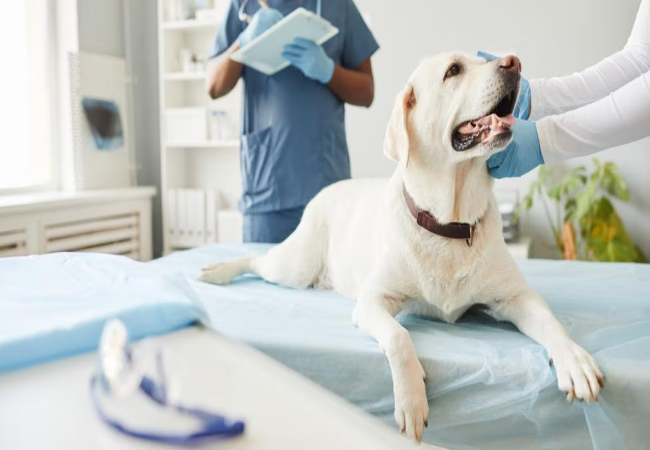Canine Osteomyelitis – Vet Guide 2025 🐶🦴🩺

In this article
Canine Osteomyelitis – Vet Guide 2025 🐶🦴🩺
By Dr. Duncan Houston BVSc
Hello, I’m Dr Duncan Houston, BVSc, founder of Ask A Vet. Osteomyelitis is a serious infection—involving bone and bone marrow caused by bacteria or fungi. It requires prompt, long-term care to protect your dog’s bones and overall health. This 2025 guide covers causes, symptoms, diagnostic steps, treatments, prognosis, and supportive home care. Let’s dig in and defend your dog’s skeletal health. 🛡️
📘 What is Osteomyelitis?
Osteomyelitis is inflammation of the bone (and/or marrow) due to infection, most commonly bacterial (e.g., Staph, E. coli, Pasteurella), and occasionally fungal (e.g., Aspergillus, Histoplasma, Coccidioides). The infection spreads either via bloodstream (hematogenous) or directly from trauma, surgery, implants, or dental disease.
⚠️ Types & Risk Factors
- Acute: rapid onset with pain, fever, swelling, lameness.
- Chronic: long-standing, may show draining tracts or bone changes.
- Bacterial: most common.
- Fungal: geographically dependent (e.g., SW USA).
How Infection Enters Bone:
- Blood spread from distant infections (common in puppies).
- Trauma, fractures, bites, gunshots, penetrating wounds.
- Post-operative or implant-associated infections.
- Severe dental or jaw disease.
🚩 Clinical Signs
- Lameness or reluctance to bear weight.
- Pain, swelling, heat, or draining tracts over bones.
- Systemic symptoms: fever, lethargy, anorexia, depression.
- Jaw involvement: difficulty eating, halitosis for mandibular osteomyelitis.
🔍 Diagnostic Workflow
- History & Exam: focus on onset, trauma, implants, jaw issues.
- Lab testing: CBC/Chem, inflammatory markers; may show leukocytosis or elevated markers.
- Imaging: X-rays: bone lysis, periosteal reaction, sequestra. Ultrasound/CT/MRI for soft tissue and marrow inflammation.
- Culture & Biopsy: aspirate exudate, bone biopsy, implant cultures.
- Blood cultures: for suspected hematogenous spread.
- Dental assessment: jaw infections often diagnosed via oral exam/X-ray.
💊 Treatment Strategies
1. Medical
- Antibiotics: guided by culture—long durations: 4–6 weeks for acute, 6–12+ weeks for chronic. Common choices: amoxicillin/clavulanate, cefazolin, clindamycin, enrofloxacin (dogs), amikacin.
- Antifungals: for fungal involvement—such as itraconazole, fluconazole.
2. Surgical
- Debridement of necrotic bone and draining tracts; removal of infected implants.
- Wound drainage, lavage, and potential bone grafting if needed.
- Dental extraction for jaw cases.
- Amputation may be necessary for refractory or severe limb infections.
3. Supportive Management
- Pain control: NSAIDs and analgesics.
- IV fluids, warmth, and nutritional support during treatment.
- Physical rest and slow return to activity.
⏳ Prognosis & Outcome
- Around 90% of dogs respond to combined medical and surgical treatment.
- Localized jaw osteomyelitis generally has a good prognosis.
- Implant or fracture-associated bone infections and chronic disease carry guarded to poor outlook; amputation may be lifesaving.
- Relapse is possible if treatment is incomplete or implants remain infected.
🏠 Home Care & Monitoring
- Strict adherence to the antibiotic schedule until vet confirms completion.
- Keep surgical wounds clean and bandaged as instructed.
- Monitor for fever, swelling, and drainage—report any concerns immediately.
- Ensure pain relief and prevent weight-bearing until vet gives clearance.
- Provide supportive care: quiet space, easy access to food/water.
- Maintain follow-up X-rays, labs, and potential implant checks.
🔎 Prevention Tips
- Prompt treatment of wounds, fractures, and dental disease.
- Veterinary-grade sterility during surgery and timely implant removal.
- Monitor puppies for signs of bacteremia; treat infections early.
✨ Key Takeaways
- Osteomyelitis is a serious bone infection that needs proactive diagnosis and treatment.
- Diagnosis uses labs, imaging, culture, and often a bone biopsy.
- Treatment includes long-term antimicrobials, surgical cleaning, and sometimes amputation.
- With proper care, many dogs recover, but chronic or implant-associated cases are more challenging.
- Home care and follow-up are essential to ensure full recovery.
🐾 Ask A Vet
- Get specialist consultation via Ask A Vet to optimize your dog’s treatment plan.
If your dog shows signs of bone pain, swelling, fever—and especially if there’s a history of injury or surgery—reach out to your vet or Ask A Vet right away. Early, aggressive treatment protects your dog’s bones and boosts recovery success. 🩺






